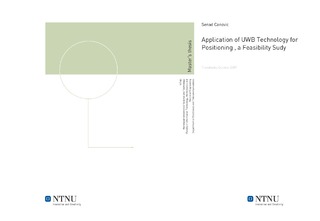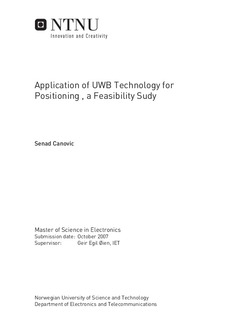| dc.contributor.advisor | Øien, Geir Egil | nb_NO |
| dc.contributor.author | Canovic, Senad | nb_NO |
| dc.date.accessioned | 2014-12-19T13:43:30Z | |
| dc.date.accessioned | 2015-12-22T11:41:04Z | |
| dc.date.available | 2014-12-19T13:43:30Z | |
| dc.date.available | 2015-12-22T11:41:04Z | |
| dc.date.created | 2010-09-03 | nb_NO |
| dc.date.issued | 2007 | nb_NO |
| dc.identifier | 347581 | nb_NO |
| dc.identifier | ntnudaim:3684 | |
| dc.identifier.uri | http://hdl.handle.net/11250/2369117 | |
| dc.description.abstract | Ultra wideband (UWB) signaling and its usability in positioning schemes has been discussed in this report. A description of UWB technology has been provided with a view on both the advantages and disadvantages involved. The main focus has been on Impulse Radio UWB (IR-UWB) since this is the most common way of emitting UWB signals. IR-UWB operates at a very large bandwidth at a low power. This is based on a technique that consists of emitting very short pulses (in the order of nanoseconds) at a very high rate. The result is low power consumption at the transmitter but an increased complexity at the receiver. The transmitter is based on the so-called Time Hopping UWB (TH-UWB) scheme while the receiver is a RAKE receiver with five branches. IR-UWB also provides good multipath properties, secure transmission, and accurate positioning whith the latter being the main focus of this report. Four positioning methods are presented with a view on finding which is the most suitable for UWB signaling. Received Signal Strength (RSS), Angle Of Arrival (AOA), Time Of Arrival (TOA) and Time Difference Of Arrival (TDOA) are all considered, and TDOA is found to be the most appropriate. Increasing the SNR or the effective bandwidth increases the accuracy of the time based positioning schemes. TDOA thus exploits the large bandwidth of UWB signals to achieve more accurate positioning in addition to synchronization advantages over TOA. The TDOA positioning scheme is tested under realistic conditions and the results are provided. A sensor network is simulated based on indications provided by WesternGeco. Each sensor consists of a transmitter and receiver which generate and receive signals transmitted over a channel modeled after the IEEE 802.15.SG3 channel model. It is shown that the transmitter power and sampling frequency, the distance between the nodes and the position of the target node all influence the accuracy of the positioning scheme. For a common sampling frequency of 55 GHz, power levels of -10 dBm, -7.5 dBm and -5 dBm are needed in order to achieve satisfactory positioning at distances of 8, 12, and 15 meters respectively. The need for choosing appropriate reference nodes for the cases when the target node is selected on the edges of the network is also pointed out. | nb_NO |
| dc.language | eng | nb_NO |
| dc.publisher | Institutt for elektronikk og telekommunikasjon | nb_NO |
| dc.subject | ntnudaim | no_NO |
| dc.subject | SIE6 elektronikk | |
| dc.subject | Signalbehandling og kommunikasjon | |
| dc.title | Application of UWB Technology for Positioning, a Feasibility Sudy | nb_NO |
| dc.type | Master thesis | nb_NO |
| dc.source.pagenumber | 85 | nb_NO |
| dc.contributor.department | Norges teknisk-naturvitenskapelige universitet, Fakultet for informasjonsteknologi, matematikk og elektroteknikk, Institutt for elektronikk og telekommunikasjon | nb_NO |

